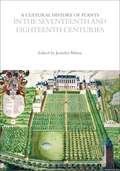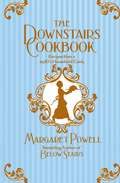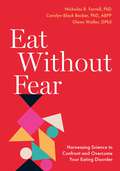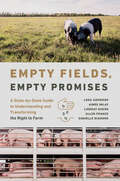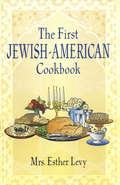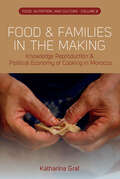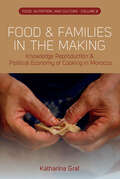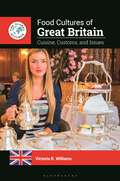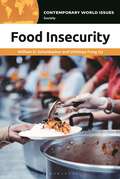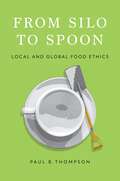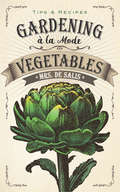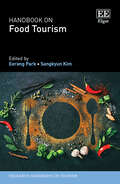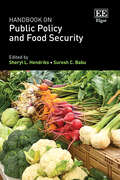- Table View
- List View
A Cultural History of Plants in the Post-Classical Era (The Cultural Histories Series)
A Cultural History of Plants in the Post-Classical Era covers the period from 500 to 1400, ranging across northern and central Europe to the Mediterranean, and from the Byzantine and Arabic Empires to the Persian World, India, and China. This was an age of empires and fluctuating borders, presenting a changing mosaic of environments, populations, and cultural practices. Many of the ancient uses and meanings of plants were preserved, but these were overlaid with new developments in agriculture, landscapes, medicine, eating habits, and art.The six-volume set of the Cultural History of Plants presents the first comprehensive history of the uses and meanings of plants from prehistory to today. The themes covered in each volume are plants as staple foods; plants as luxury foods; trade and exploration; plant technology and science; plants and medicine; plants in culture; plants as natural ornaments; the representation of plants.Alain Touwaide is Scientific Director at the Institute for the Preservation of Medical Traditions, Washington, D.C., USA.A Cultural History of Plants in the Post-Classical Era is the second volume in the six-volume set, A Cultural History of Plants, also available online as part of Bloomsbury Cultural History, a fully-searchable digital library (see www.bloomsburyculturalhistory.com).General Editors: Annette Giesecke, University of Delaware, USA, and David Mabberley, University of Oxford, UK.
A Cultural History of Plants in the Seventeenth and Eighteenth Centuries (The Cultural Histories Series)
A Cultural History of Plants in the Seventeenth and Eighteenth Centuries covers the period from 1650 to 1800,a time of global exploration and the discovery of new species of plants and their potential uses. Trade routes were established which brought Europeans into direct contact with the plants and people of Asia, Oceania, Africa and the Americas. Foreign and exotic plants become objects of cultivation, collection, and display, whilst the applications of plants became central not only to naturalists, landowners, and gardeners but also to philosophers, artists, merchants, scientists, and rulers. As the Enlightenment took hold, the natural world became something to be grasped through reasoned understanding. The 6 volume set of the Cultural History of Plants presents the first comprehensive history of the uses and meanings of plants from prehistory to today. The themes covered in each volume are plants as staple foods; plants as luxury foods; trade and exploration; plant technology and science; plants and medicine; plants in culture; plants as natural ornaments; the representation of plants. Jennifer Milam is Pro Vice-Chancellor and Professor of Art History, University of Newcastle, Australia. Volume 4 in the Cultural History of Plants set.General Editors: Annette Giesecke, University of Delaware, USA, and David Mabberley, University of Oxford, UK.
Cupcake (Large Print)
This is a picture of a cupcake. It is in the middle of the page. There is a locator dot shown, which will be at the top left of the page when the image is the correct way up. At the top of the picture a glace cherry is sitting on some pink sugar icing. Below this is the cake overflowing the top of the paper cup below.
Cupcake (UEB Contracted)
This is a picture of a cupcake. It is in the middle of the page. There is a locator dot shown, which will be at the top left of the page when the image is the correct way up. At the top of the picture a glace cherry is sitting on some pink sugar icing. Below this is the cake overflowing the top of the paper cup below.
Cupcake (UEB Uncontracted)
This is a picture of a cupcake. It is in the middle of the page. There is a locator dot shown, which will be at the top left of the page when the image is the correct way up. At the top of the picture a glace cherry is sitting on some pink sugar icing. Below this is the cake overflowing the top of the paper cup below.
Diet, Life Expectancy, And Chronic Disease: Studies Of Seventh-day Adventists And Other Vegetarians
by Gary E. FraserThe Downstairs Cookbook: Recipes From A 1920s Household Cook
by Margaret PowellThe Downstairs Cookbook offers genuine 1920s recipes from bestselling author Margaret Powell, the house maid and cook who shared tales from her years of service in Below Stairs and inspired the original Upstairs Downstairs TV series. Now in this cookery book she offers a collection of sweet and savoury courses that the servants regularly prepared for their masters upstairs, accompanied throughout by her heartwarming anecdotes from life in service. The recipes include retro classics such as kedgeree, jugged hare and angels on horseback as well as more adventurous offerings such as lobster soufflé and veal quenelles. With separate chapters on pastry and preserves, this is Margaret Powell’s complete cook’s manual for a 1920s household.
Eat Without Fear: Harnessing Science to Confront and Overcome Your Eating Disorder
by Nicholas Farrell Carolyn Becker Glenn WallerEating disorders are serious conditions that can be hard to treat; however, the chances of overcoming an eating disorder increase when exposure therapy is used as part of the overall treatment strategy. Exposure therapy involves confronting (rather than avoiding) challenging scenarios that evoke distress, and though this technique has typically been used mainly by psychotherapists, people struggling with eating disorders can use it on their own to reduce troubling eating behaviors. Eat Without Fear provides practical, reader-friendly information about this innovative, scientifically-supported approach, as well as guidance on how to apply it effectively to beat an eating disorder using a "team approach" that involves family members, friends, and other loved ones. Readers will benefit from the use of easy-to-understand language describing the key concepts of eating disorders and how exposure therapy can help treat them. Additionally, the book guides readers through therapeutic activities that enable them to effectively practice exposure therapy techniques on their own. Given the value of involving family members and other supportive people in the eating disorder recovery process, this book encourages collaboration between readers and their loved ones and offers practical suggestions for how they can work together to achieve their desired goals.
Empty Fields, Empty Promises: A State-by-State Guide to Understanding and Transforming the Right to Farm (Rural Studies Series)
by Loka Ashwood Danielle Diamond Allen Franco Aimee Imlay Lindsay KuehnThe right to farm is essential to everyone's survival. Since the late 1970s, states across the nation have adopted so-called right-to-farm laws to limit nuisance suits loosely related to agriculture. But since their adoption, there has yet to be a comprehensive analysis of what these laws do and who they benefit. This book offers the first national analysis and guide to these laws. It reveals that they generally benefit the largest operators, like processing plants, while traditional farmers benefit the least. Disfavored most of all are those seeking to defend their homes and environment against multinational corporations that use right-to-farm laws to strip neighboring owners of their property rights. Through what the book calls the "midburden," right-to-farm laws dispossess the many in favor of the few, paving the path to rural poverty. Empty Fields, Empty Promises summarizes every state's right-to-farm laws to help readers track and navigate their local and regional legal landscape. The book concludes by offering paths forward for a more distributed and democratic agrifood system that achieves agricultural, rural, and environmental justice.
The First Jewish-American Cookbook
by Esther LevyA remarkable culinary and historical document that offers housekeeping and domestic management advice, as well as daily menu suggestions, a Jewish calendar, and a selection of medical and household recipes. Delicious and economical, the recipes feature ingredients readily available to modern cooks, with instructions that are abundantly clear.
Food and Families in the Making: Knowledge Reproduction and Political Economy of Cooking in Morocco (Food, Nutrition, and Culture #8)
by Katharina GrafEven in the context of rapid material and social change in urban Morocco, women, and especially those from low-income households, continue to invest a lot of work in preparing good food for their families. Through the lens of domestic food preparation, this book looks at knowledge reproduction, how we know cooking and its role in the making of everyday family life. It also examines a political economy of cooking that situates Marrakchi women’s lived experiences in the broader context of persisting poverty and food insecurity in Morocco.
Food and Families in the Making: Knowledge Reproduction and Political Economy of Cooking in Morocco (Food, Nutrition, and Culture #8)
by Katharina GrafEven in the context of rapid material and social change in urban Morocco, women, and especially those from low-income households, continue to invest a lot of work in preparing good food for their families. Through the lens of domestic food preparation, this book looks at knowledge reproduction, how we know cooking and its role in the making of everyday family life. It also examines a political economy of cooking that situates Marrakchi women’s lived experiences in the broader context of persisting poverty and food insecurity in Morocco.
Food Cultures of Great Britain: Cuisine, Customs, and Issues (The Global Kitchen)
by Victoria R. WilliamsThere's far more to British food than fish and chips. Discover the history and culture of Great Britain through its rich culinary traditions.Part of the Global Kitchen series, this book takes readers on a food tour of Great Britain, covering everything from daily staples to holiday specialties. In addition to discovering Great Britain's long culinary history, you'll learn about recent trends, foreign influences, and contemporary food and dietary concerns, such as obesity and the impacts of climate change. Chapters are organized thematically, making it easy to focus in on particular courses or types of dishes. The main text is supplemented by sidebars that offer interesting bite-sized facts, a chronology of important dates in British culinary history, and a glossary of key food- and dining-related terms.When people outside Great Britain think of British cuisine, they likely envision iconic foods and traditions such as fish and chips, a full English breakfast, and afternoon tea. But Great Britain has a much richer and more diverse culinary history. It has been shaped by a myriad of events, from invasions by the Romans, Vikings, and Normans to the emergence and expansion of the British Empire to the privations of World War II. In more recent times, Great Britain's departure from the European Union, the global Covid-19 pandemic, and Russia's invasion of Ukraine have all had a significant impact on the food landscape of Great Britain.
Food Insecurity: A Reference Handbook (Contemporary World Issues)
by William D. Schanbacher Whitney Fung UyThis comprehensive and authoritative one-stop resource examines the issue of food insecurity in the United States, including the various economic, social, political, and cultural factors that drive the problem.Social welfare agencies, schools, food banks, and other organizations have all put forth efforts to combat food insecurity, but it remains a serious risk for millions of poor Americans today. Food Insecurity: A Reference Handbook examines the reasons why food insecurity remains such a longstanding problem in American society.Beginning with a history of food insecurity from the country's origins to the present day, the book also delves into the problems and controversies related to food insecurity, such as urban food deserts, substance abuse impacts, nutrition education, and income inequality. One of the most valuable aspects of the book is that it surveys the history of food insecurity in a manner that helps the reader identify key issues in an easy-to-understand fashion. The book's Perspectives chapter presents a broad range of voices on various facets of food insecurity, providing crucial, diverse perspectives to round out the coverage and expertise of the authors.
Fries (Large Print)
At the centre of the page is a picture of a packet of fries. There is a locator dot shown, which will be at the top left of the page when the image is the correct way up. At the top of the picture are the fries. They are sticking up from the cardboard packet below. Can you count how many there are? The packet has a diamond shaped decoration on it.
Fries (UEB Contracted)
At the centre of the page is a picture of a packet of fries. There is a locator dot shown, which will be at the top left of the page when the image is the correct way up. At the top of the picture are the fries. They are sticking up from the cardboard packet below. Can you count how many there are? The packet has a diamond shaped decoration on it.
Fries (UEB Uncontracted)
At the centre of the page is a picture of a packet of fries. There is a locator dot shown, which will be at the top left of the page when the image is the correct way up. At the top of the picture are the fries. They are sticking up from the cardboard packet below. Can you count how many there are? The packet has a diamond shaped decoration on it.
From Silo to Spoon: Local and Global Food Ethics
by Paul B. ThompsonFollowing the pattern of From Field to Fork (OUP, 2015) Paul B. Thompson provides a highly readable and up-to-date analysis of contemporary ethical issues connected with food. Thompson reinterprets Peter Singer's work on famine relief in light of the history of funding development assistance through food aid, defends locavore diets against philosophical critics, and analyzes the ethics of food labeling in light of J.S. Mill's On Liberty. Further exploring today's key ethical questions about food, Thompson compares anthropological and toxicological approaches to pollution and defends a revised notion of agricultural sustainability. These topics provide an entry point for a novel approach in practical ethics that blends pragmatist philosophy of language, historical interpretation of agrarian thought, and recent philosophical writings on race and structural racism.
Gardening à la Mode: Vegetables
by Harriet Anne De SalisWhat's the best way to protect vegetables from frost? How do you dry herbs and banish slugs? There's much to learn about making the most of your backyard vegetable garden, and this handy little guide is brimming with advice for novice gardeners. Written by a popular magazine columnist of the nineteenth century, these timeless suggestions offer straightforward guidance for every step of the way, from planting, watering, and fertilizing to cooking and preserving your homegrown produce.Author Harriet Anne de Salis was an expert at counseling Victorian housewives on the domestic arts, writing commonsense manuals for everything from cooking on a budget to raising poultry and training dogs. This companion volume to Gardening à la Mode: Fruits features alphabetized entries and an index for easy reference. Even seasoned gardeners and cooks are likely to find it a source of useful hints and enduring charm.
Grapes (Large Print)
This is an image of a bunch of purple grapes shown life-sized in the middle of the page. There is a locator dot shown, which will be at the top left of the page when the image is the correct way up. At the top of the page, you can find the main stalk where the bunch of grapes has been cut from the vine. Further down the page, this branches off into the smaller stalks that the oval-shaped fruit hang from.
Grapes (UEB Contracted)
This is an image of a bunch of purple grapes shown life-sized in the middle of the page. There is a locator dot shown, which will be at the top left of the page when the image is the correct way up. At the top of the page, you can find the main stalk where the bunch of grapes has been cut from the vine. Further down the page, this branches off into the smaller stalks that the oval-shaped fruit hang from.
Grapes (UEB Uncontracted)
This is an image of a bunch of purple grapes shown life-sized in the middle of the page. There is a locator dot shown, which will be at the top left of the page when the image is the correct way up. At the top of the page, you can find the main stalk where the bunch of grapes has been cut from the vine. Further down the page, this branches off into the smaller stalks that the oval-shaped fruit hang from.
Handbook on Food Tourism (Research Handbooks in Tourism series)
This Handbook on Food Tourism provides an overview of the past, present, and future of research traditions, perspectives, and concerns about the food tourism phenomenon. Taking a multidisciplinary approach, it contributes to the historical and anthropological understanding of the nexus between food, society, and tourism that underpins the divergent business and marketing efforts in tourism today.Expert contributors from across the globe not only explore the theoretical and conceptual foundations of food tourism research, but also address the significance of the multistakeholder nature of tourism in the context of food tourism development. Chapters present empirical research using quantitative and qualitative methods, conceptual papers and critical literature reviews employing archival research methods and informetric mapping, and analysis of secondary data from social, political, and environmental sources. Rich with information and data about diverse socio-cultural and environmental issues, this Handbook consolidates knowledge on the studies of food tourism from around the world and provides a vision for future research.Covering the breadth of food tourism research, this Handbook will be a fundamental reference work for researchers, academics, and students in tourism management, human geography, social and cultural geography, and business and management. It will similarly appeal to professionals, local authorities, and local food and tourism industries and businesses.
Handbook on Public Policy and Food Security
The Handbook on Public Policy and Food Security provides multi-disciplinary insights into food security analysis across the Sustainable Development Goals (SDGs). As food security is an essential outcome and a part of sustainable and healthy food systems, this Handbook addresses the urgent need to provide a comprehensive overview of the field’s current developments.Paired chapters focuses on a specific SDG in turn, presenting an overview and using qualitative and quantitative methodological approaches to assess the impact of food security on the attainment of the specific goal, and the evaluation of the impact of the goal on food security. This Handbook brings together experts in the field who advocate for a food systems approach, highlighting how various components of a food system function together to achieve the goal of food security for all. The cross-policy themes covered extend beyond the SDGs, proving relevant for public policy and food security in the foreseeable future. This erudite Handbook will be highly informative for academics, researchers and students in agricultural economics, development studies, human geography, human rights and comparative social policy. It will also be beneficial for professionals working in public policy, NGOs and multilateral organisations who are interested in understanding food security and nutrition monitoring.

